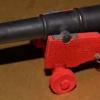-
Posts
3,084 -
Joined
-
Last visited
Reputation Activity
-
 Jaager got a reaction from allanyed in When to varnish
Jaager got a reaction from allanyed in When to varnish
Most varnish products will probably not play nice with most glues.
The glue will "bond" to the finish rather than the wood. With no
pores there is no penetration so any bonding will be electrostatic
rather than mechanical.
Traditional varnish is boiled linseed oil "cooked" with shellac - organic solvents.
These days polyurethane seems to be more popular and there are
water based varieties. It is a synthetic plastic.
If you are doing an upscale modern yacht, varnished decks may be appropriate.
You wear no scuff deck shoes to walk on them.
For most other classes of wooden ships, a slick varnished deck would be really
dangerous for the crew.
Because of scale effect, a flat or egg shell finish even for high gloss prototypes -
or at most matte..
You might consider super blonde shellac at half strength ( 5%) * and rub it down
with 0000 steel wool or a Scotch Brite pad. In any case, if you intend to apply a
finish before adding and gluing down additional components - it would be wise to
occlude the glue sites with painters tape or masking tape.
* orange shellac is full strength at 20 lb cut ( ~ 20% solution in methanol,
ethanol (denatured) or ( Pharmco grain - 95% - if you do not mind paying the taxes),
or anhydrous isopropyl.
It will darken the wood.
super blonde shellac is a very light amber. The purification process removes components
that help solubilize it - so - full strength is 10 lb cut ( ~10%). Primer or 1st coat = 5%.
There is a bit clearer grade: plantina shellac flakes - but it is not that lighter and costs about
twice what super blonde costs.
-
 Jaager got a reaction from Landlocked123 in When to varnish
Jaager got a reaction from Landlocked123 in When to varnish
Most varnish products will probably not play nice with most glues.
The glue will "bond" to the finish rather than the wood. With no
pores there is no penetration so any bonding will be electrostatic
rather than mechanical.
Traditional varnish is boiled linseed oil "cooked" with shellac - organic solvents.
These days polyurethane seems to be more popular and there are
water based varieties. It is a synthetic plastic.
If you are doing an upscale modern yacht, varnished decks may be appropriate.
You wear no scuff deck shoes to walk on them.
For most other classes of wooden ships, a slick varnished deck would be really
dangerous for the crew.
Because of scale effect, a flat or egg shell finish even for high gloss prototypes -
or at most matte..
You might consider super blonde shellac at half strength ( 5%) * and rub it down
with 0000 steel wool or a Scotch Brite pad. In any case, if you intend to apply a
finish before adding and gluing down additional components - it would be wise to
occlude the glue sites with painters tape or masking tape.
* orange shellac is full strength at 20 lb cut ( ~ 20% solution in methanol,
ethanol (denatured) or ( Pharmco grain - 95% - if you do not mind paying the taxes),
or anhydrous isopropyl.
It will darken the wood.
super blonde shellac is a very light amber. The purification process removes components
that help solubilize it - so - full strength is 10 lb cut ( ~10%). Primer or 1st coat = 5%.
There is a bit clearer grade: plantina shellac flakes - but it is not that lighter and costs about
twice what super blonde costs.
-
 Jaager got a reaction from hornet in When to varnish
Jaager got a reaction from hornet in When to varnish
Most varnish products will probably not play nice with most glues.
The glue will "bond" to the finish rather than the wood. With no
pores there is no penetration so any bonding will be electrostatic
rather than mechanical.
Traditional varnish is boiled linseed oil "cooked" with shellac - organic solvents.
These days polyurethane seems to be more popular and there are
water based varieties. It is a synthetic plastic.
If you are doing an upscale modern yacht, varnished decks may be appropriate.
You wear no scuff deck shoes to walk on them.
For most other classes of wooden ships, a slick varnished deck would be really
dangerous for the crew.
Because of scale effect, a flat or egg shell finish even for high gloss prototypes -
or at most matte..
You might consider super blonde shellac at half strength ( 5%) * and rub it down
with 0000 steel wool or a Scotch Brite pad. In any case, if you intend to apply a
finish before adding and gluing down additional components - it would be wise to
occlude the glue sites with painters tape or masking tape.
* orange shellac is full strength at 20 lb cut ( ~ 20% solution in methanol,
ethanol (denatured) or ( Pharmco grain - 95% - if you do not mind paying the taxes),
or anhydrous isopropyl.
It will darken the wood.
super blonde shellac is a very light amber. The purification process removes components
that help solubilize it - so - full strength is 10 lb cut ( ~10%). Primer or 1st coat = 5%.
There is a bit clearer grade: plantina shellac flakes - but it is not that lighter and costs about
twice what super blonde costs.
-
 Jaager got a reaction from flying_dutchman2 in Making Rope
Jaager got a reaction from flying_dutchman2 in Making Rope
This I did using a Byrnes rope walk. I will have to play with the setup
to get the warps more acute but that should not affect these data significantly.
100/3 = 100 LEA linen yarn spun up using 3 yarns.
The diameter was measured using a lacquered dowel and counting the
closely packed rotations in an inch.
-
 Jaager got a reaction from thibaultron in Byrnes Drawplate
Jaager got a reaction from thibaultron in Byrnes Drawplate
There are also draw tongs. They are for gripping wire, but work with
bamboo - if pieces of sandpaper are used as an interface to grip and
you do not squeeze too hard.
-
 Jaager got a reaction from mtaylor in Byrnes Drawplate
Jaager got a reaction from mtaylor in Byrnes Drawplate
There are also draw tongs. They are for gripping wire, but work with
bamboo - if pieces of sandpaper are used as an interface to grip and
you do not squeeze too hard.
-
 Jaager got a reaction from Canute in Byrnes Drawplate
Jaager got a reaction from Canute in Byrnes Drawplate
There are also draw tongs. They are for gripping wire, but work with
bamboo - if pieces of sandpaper are used as an interface to grip and
you do not squeeze too hard.
-
 Jaager got a reaction from Mike Y in Inert gas in a completed model's display case for preservation?
Jaager got a reaction from Mike Y in Inert gas in a completed model's display case for preservation?
It may not be a significant level of energy with LED lighting or florescent either, but
the way greenhouse effect works is that some visible energy photons will degrade
to IR when they strike something inside the chamber and the transparent material at
visible will reflect IR and keep it inside. Granted, most will stay in the visible spectrum
and reflect back out. - We would be able to see what was inside otherwise. - But while
a UV filter may protect against the chemical reactions that UV produces, I doubt that
it would negate a heat build up in an efficiently sealed chamber.
With your room lighting, the lack of heat with LED even given your high light level, shows
just how inefficient and IR heavy incandescent lighting is. However, given where you
live, there may be parts of the year where you might miss having a little extra IR.
When I was using 300 W of bulbs to heat a homemade kiln 24/7, I did have a measurable
increase in my electric bill.
Our philosophy seems to be in tune, I also have a tendency to over engineer my designs.
-
 Jaager got a reaction from reklein in Inert gas in a completed model's display case for preservation?
Jaager got a reaction from reklein in Inert gas in a completed model's display case for preservation?
It may not be a significant level of energy with LED lighting or florescent either, but
the way greenhouse effect works is that some visible energy photons will degrade
to IR when they strike something inside the chamber and the transparent material at
visible will reflect IR and keep it inside. Granted, most will stay in the visible spectrum
and reflect back out. - We would be able to see what was inside otherwise. - But while
a UV filter may protect against the chemical reactions that UV produces, I doubt that
it would negate a heat build up in an efficiently sealed chamber.
With your room lighting, the lack of heat with LED even given your high light level, shows
just how inefficient and IR heavy incandescent lighting is. However, given where you
live, there may be parts of the year where you might miss having a little extra IR.
When I was using 300 W of bulbs to heat a homemade kiln 24/7, I did have a measurable
increase in my electric bill.
Our philosophy seems to be in tune, I also have a tendency to over engineer my designs.
-
 Jaager got a reaction from thibaultron in Inert gas in a completed model's display case for preservation?
Jaager got a reaction from thibaultron in Inert gas in a completed model's display case for preservation?
It may not be a significant level of energy with LED lighting or florescent either, but
the way greenhouse effect works is that some visible energy photons will degrade
to IR when they strike something inside the chamber and the transparent material at
visible will reflect IR and keep it inside. Granted, most will stay in the visible spectrum
and reflect back out. - We would be able to see what was inside otherwise. - But while
a UV filter may protect against the chemical reactions that UV produces, I doubt that
it would negate a heat build up in an efficiently sealed chamber.
With your room lighting, the lack of heat with LED even given your high light level, shows
just how inefficient and IR heavy incandescent lighting is. However, given where you
live, there may be parts of the year where you might miss having a little extra IR.
When I was using 300 W of bulbs to heat a homemade kiln 24/7, I did have a measurable
increase in my electric bill.
Our philosophy seems to be in tune, I also have a tendency to over engineer my designs.
-
 Jaager got a reaction from Canute in Inert gas in a completed model's display case for preservation?
Jaager got a reaction from Canute in Inert gas in a completed model's display case for preservation?
It may not be a significant level of energy with LED lighting or florescent either, but
the way greenhouse effect works is that some visible energy photons will degrade
to IR when they strike something inside the chamber and the transparent material at
visible will reflect IR and keep it inside. Granted, most will stay in the visible spectrum
and reflect back out. - We would be able to see what was inside otherwise. - But while
a UV filter may protect against the chemical reactions that UV produces, I doubt that
it would negate a heat build up in an efficiently sealed chamber.
With your room lighting, the lack of heat with LED even given your high light level, shows
just how inefficient and IR heavy incandescent lighting is. However, given where you
live, there may be parts of the year where you might miss having a little extra IR.
When I was using 300 W of bulbs to heat a homemade kiln 24/7, I did have a measurable
increase in my electric bill.
Our philosophy seems to be in tune, I also have a tendency to over engineer my designs.
-
 Jaager got a reaction from mtaylor in HMS Beagle figurehead info. (edited by admin)
Jaager got a reaction from mtaylor in HMS Beagle figurehead info. (edited by admin)
Marquardt has a dog sculpture and a scroll as options. I'm pretty sure it would take a wayback machine to know for sure.
Unless new data becomes available, which ever option you choose can not be authoritatively refuted.
-
 Jaager got a reaction from mtaylor in Inert gas in a completed model's display case for preservation?
Jaager got a reaction from mtaylor in Inert gas in a completed model's display case for preservation?
It may not be a significant level of energy with LED lighting or florescent either, but
the way greenhouse effect works is that some visible energy photons will degrade
to IR when they strike something inside the chamber and the transparent material at
visible will reflect IR and keep it inside. Granted, most will stay in the visible spectrum
and reflect back out. - We would be able to see what was inside otherwise. - But while
a UV filter may protect against the chemical reactions that UV produces, I doubt that
it would negate a heat build up in an efficiently sealed chamber.
With your room lighting, the lack of heat with LED even given your high light level, shows
just how inefficient and IR heavy incandescent lighting is. However, given where you
live, there may be parts of the year where you might miss having a little extra IR.
When I was using 300 W of bulbs to heat a homemade kiln 24/7, I did have a measurable
increase in my electric bill.
Our philosophy seems to be in tune, I also have a tendency to over engineer my designs.
-
 Jaager got a reaction from Mike Y in Inert gas in a completed model's display case for preservation?
Jaager got a reaction from Mike Y in Inert gas in a completed model's display case for preservation?
I have thought about the same ideas.
For the gas to remain, the container would have to be
air tight. The walls are transparent, so light can enter.
Being totally sealed, there is a possibility of an extreme
greenhouse effect and the container becoming oven-like.
There is a problem with this - even in a not totally air tight situation.
Joel has it correct - vent holes for circulation for both temp and
removal of outgassed compounds. PVA wood glue would probably
release acetic acid.
My thinking is vent openings at the top ( for temp ) and probably
also bottom for circulation. The trick would be to keep dust out.
Too dry - the wood may check and split over time.
.The museum standards for ship models are probably intended to
preserve a model for as long as is practical - by using materials that
last to begin with.
-
 Jaager got a reaction from mtaylor in Inert gas in a completed model's display case for preservation?
Jaager got a reaction from mtaylor in Inert gas in a completed model's display case for preservation?
I have thought about the same ideas.
For the gas to remain, the container would have to be
air tight. The walls are transparent, so light can enter.
Being totally sealed, there is a possibility of an extreme
greenhouse effect and the container becoming oven-like.
There is a problem with this - even in a not totally air tight situation.
Joel has it correct - vent holes for circulation for both temp and
removal of outgassed compounds. PVA wood glue would probably
release acetic acid.
My thinking is vent openings at the top ( for temp ) and probably
also bottom for circulation. The trick would be to keep dust out.
Too dry - the wood may check and split over time.
.The museum standards for ship models are probably intended to
preserve a model for as long as is practical - by using materials that
last to begin with.
-
 Jaager got a reaction from jbshan in Inert gas in a completed model's display case for preservation?
Jaager got a reaction from jbshan in Inert gas in a completed model's display case for preservation?
I have thought about the same ideas.
For the gas to remain, the container would have to be
air tight. The walls are transparent, so light can enter.
Being totally sealed, there is a possibility of an extreme
greenhouse effect and the container becoming oven-like.
There is a problem with this - even in a not totally air tight situation.
Joel has it correct - vent holes for circulation for both temp and
removal of outgassed compounds. PVA wood glue would probably
release acetic acid.
My thinking is vent openings at the top ( for temp ) and probably
also bottom for circulation. The trick would be to keep dust out.
Too dry - the wood may check and split over time.
.The museum standards for ship models are probably intended to
preserve a model for as long as is practical - by using materials that
last to begin with.
-
 Jaager got a reaction from flying_dutchman2 in Making Rope
Jaager got a reaction from flying_dutchman2 in Making Rope
The linen supplier twists up the fibers into yarn.
This is sold as LEA - which is essentially an obsolete measurement - it has been replaced -
but I have not mentally absorbed it. Since I have obtained about as much and as wide a
variety of linen yarn as is obtainable now, I don't need to deal with the change.
And yes, with LEA - the larger the number - the smaller the yarn.
From our perspective the hope would be that 70.2 LEA yarn would be 2 lines with a final size of 70,
but alas - what it means is
Two 70 LEA yarns twisted together and sold as a loosely twisted thread..
If unraveled it would be two 70 LEA yarns - not two 140 LEA - which would be nice for us
except - twisting up the 62 LEA is difficult - it breaks easily - so that may be the practical limit.
I finally got why the old guys favored linen - the linen wrapping on Egyptian mummies is still largely intact.
It does not readily oxidize.
-
 Jaager got a reaction from aviaamator in Making Rope
Jaager got a reaction from aviaamator in Making Rope
This I did using a Byrnes rope walk. I will have to play with the setup
to get the warps more acute but that should not affect these data significantly.
100/3 = 100 LEA linen yarn spun up using 3 yarns.
The diameter was measured using a lacquered dowel and counting the
closely packed rotations in an inch.
-
 Jaager got a reaction from Canute in Inert gas in a completed model's display case for preservation?
Jaager got a reaction from Canute in Inert gas in a completed model's display case for preservation?
I have thought about the same ideas.
For the gas to remain, the container would have to be
air tight. The walls are transparent, so light can enter.
Being totally sealed, there is a possibility of an extreme
greenhouse effect and the container becoming oven-like.
There is a problem with this - even in a not totally air tight situation.
Joel has it correct - vent holes for circulation for both temp and
removal of outgassed compounds. PVA wood glue would probably
release acetic acid.
My thinking is vent openings at the top ( for temp ) and probably
also bottom for circulation. The trick would be to keep dust out.
Too dry - the wood may check and split over time.
.The museum standards for ship models are probably intended to
preserve a model for as long as is practical - by using materials that
last to begin with.
-
 Jaager got a reaction from thibaultron in Inert gas in a completed model's display case for preservation?
Jaager got a reaction from thibaultron in Inert gas in a completed model's display case for preservation?
I have thought about the same ideas.
For the gas to remain, the container would have to be
air tight. The walls are transparent, so light can enter.
Being totally sealed, there is a possibility of an extreme
greenhouse effect and the container becoming oven-like.
There is a problem with this - even in a not totally air tight situation.
Joel has it correct - vent holes for circulation for both temp and
removal of outgassed compounds. PVA wood glue would probably
release acetic acid.
My thinking is vent openings at the top ( for temp ) and probably
also bottom for circulation. The trick would be to keep dust out.
Too dry - the wood may check and split over time.
.The museum standards for ship models are probably intended to
preserve a model for as long as is practical - by using materials that
last to begin with.
-
 Jaager got a reaction from Mark P in Inert gas in a completed model's display case for preservation?
Jaager got a reaction from Mark P in Inert gas in a completed model's display case for preservation?
I have thought about the same ideas.
For the gas to remain, the container would have to be
air tight. The walls are transparent, so light can enter.
Being totally sealed, there is a possibility of an extreme
greenhouse effect and the container becoming oven-like.
There is a problem with this - even in a not totally air tight situation.
Joel has it correct - vent holes for circulation for both temp and
removal of outgassed compounds. PVA wood glue would probably
release acetic acid.
My thinking is vent openings at the top ( for temp ) and probably
also bottom for circulation. The trick would be to keep dust out.
Too dry - the wood may check and split over time.
.The museum standards for ship models are probably intended to
preserve a model for as long as is practical - by using materials that
last to begin with.
-
 Jaager got a reaction from allanyed in Making Rope
Jaager got a reaction from allanyed in Making Rope
The linen supplier twists up the fibers into yarn.
This is sold as LEA - which is essentially an obsolete measurement - it has been replaced -
but I have not mentally absorbed it. Since I have obtained about as much and as wide a
variety of linen yarn as is obtainable now, I don't need to deal with the change.
And yes, with LEA - the larger the number - the smaller the yarn.
From our perspective the hope would be that 70.2 LEA yarn would be 2 lines with a final size of 70,
but alas - what it means is
Two 70 LEA yarns twisted together and sold as a loosely twisted thread..
If unraveled it would be two 70 LEA yarns - not two 140 LEA - which would be nice for us
except - twisting up the 62 LEA is difficult - it breaks easily - so that may be the practical limit.
I finally got why the old guys favored linen - the linen wrapping on Egyptian mummies is still largely intact.
It does not readily oxidize.
-
 Jaager got a reaction from allanyed in Making Rope
Jaager got a reaction from allanyed in Making Rope
This I did using a Byrnes rope walk. I will have to play with the setup
to get the warps more acute but that should not affect these data significantly.
100/3 = 100 LEA linen yarn spun up using 3 yarns.
The diameter was measured using a lacquered dowel and counting the
closely packed rotations in an inch.
-
 Jaager got a reaction from druxey in Making Rope
Jaager got a reaction from druxey in Making Rope
This I did using a Byrnes rope walk. I will have to play with the setup
to get the warps more acute but that should not affect these data significantly.
100/3 = 100 LEA linen yarn spun up using 3 yarns.
The diameter was measured using a lacquered dowel and counting the
closely packed rotations in an inch.
-
 Jaager got a reaction from druxey in Making Rope
Jaager got a reaction from druxey in Making Rope
The linen supplier twists up the fibers into yarn.
This is sold as LEA - which is essentially an obsolete measurement - it has been replaced -
but I have not mentally absorbed it. Since I have obtained about as much and as wide a
variety of linen yarn as is obtainable now, I don't need to deal with the change.
And yes, with LEA - the larger the number - the smaller the yarn.
From our perspective the hope would be that 70.2 LEA yarn would be 2 lines with a final size of 70,
but alas - what it means is
Two 70 LEA yarns twisted together and sold as a loosely twisted thread..
If unraveled it would be two 70 LEA yarns - not two 140 LEA - which would be nice for us
except - twisting up the 62 LEA is difficult - it breaks easily - so that may be the practical limit.
I finally got why the old guys favored linen - the linen wrapping on Egyptian mummies is still largely intact.
It does not readily oxidize.














